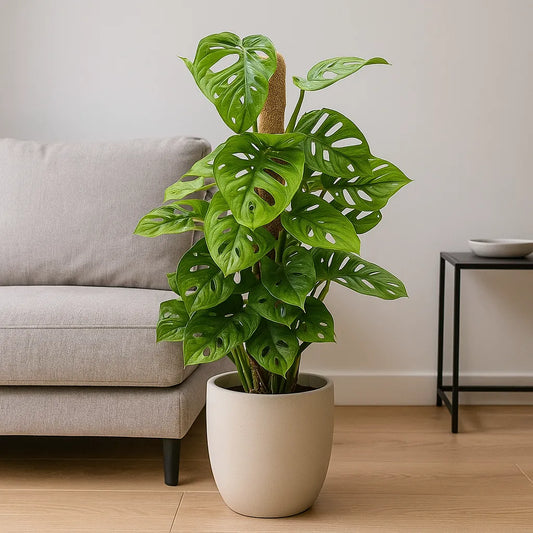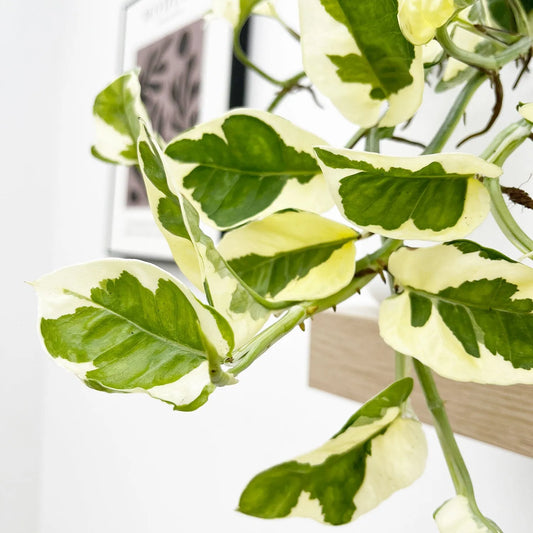Looking after your houseplants
Having house plants in your home might be on-trend at the moment but they have other benefits too. Adding a bit of greenery to your home helps to brighten up your interior design, boost your mood and it’s good for your health too. If you don’t have a big garden or you love gardening outside and want to bring a bit of greenery into your home, house plants are a great option. Whether you’re caring for houseplants for the first time or you’re struggling to keep anything alive, our complete guide to looking after house plants will help.
Where should you grow your plants?
Due to their native environment mostly being tropical and subtropical, houseplants tend to thrive in rooms where the temperature stays warm and even throughout the year.
It’s important to choose a room or spot in your home for your houseplants with plenty of sunlight as the quality, duration and intensity will all have a direct impact on your plant’s growth. However, you must also avoid direct sunlight so a spot with plenty of indirect sunlight or in a well-lit place will give your houseplants the best chance of survival.
In the winter, you should put your houseplants in rooms that do not get overheated in the day but in which the minimum required temperature for the plant is maintained. And keep them away from open fires, radiators, draughts or window sills on cold nights.
It’s important to try not to move your plants around too much. They acclimatise to their surroundings slowly so moving them around can confuse them and mean that they won’t thrive as well. Make sure you avoid rooms such as conservatories where there can be drastic changes in temperature.
Can plants get too little or too much sunlight?
Yes, while plants that do not get enough sunlight suffer, so do those that get too much! Finding a balance can be tricky but it’s important if you want a set of healthy houseplants. The light requirements of houseplants varies depending on their native environments but, when you buy the plant, you should be provided with some guidelines as to the environment it prefers.
A plant that’s not getting enough light might start to look lanky as it grows extra long stems in an attempt to soak up as much light as possible. You might also notice that it leans towards the source of sunlight to get as much as it can.
On the other hand, a plant that’s getting too much light can be just as detrimental as too much water.
If a houseplant is getting too much light, it will display the following symptoms:
-
Scorched or sunburned with yellow or brown spots on the leave and browning tips
-
Wilts and soil dries out quickly after watering
How often should you water houseplants?
The amount of water a plant needs depends on the plant itself. You will find that some plants prefer more and some prefer very little. Plants with thicker leaves tend to need much less water than others because they can store it themselves for longer.
In addition, the time of year, temperature and light levels also factor in to how much an individual plant needs watering. For example, spring and summer are growing and blooming period and means some plants will need more water.
Shade loving plants will use up much less water than those that like to bask on a sunny window sill. We advise that you keep an eye on your plants and get to know their habits so you can understand how long you need to wait between waterings.
Can you overwater a plant?
Yes! In fact, overwatering is one of the most common reasons that plants do not thrive or die. Very few plants like to sit in moist soil and tend to do better if you let the soil dry out between watering.
Overwatering leads to root death and slowly kills the plant off. Once you have watered your houseplants, let the soil dry out before you water again, depending on the plant and time of year, this could be days or weeks. The easiest way to check whether a plant needs water is to stick your finger in the soil. If it’s dry, it needs watering. If it’s not, you can wait a few more days before watering again.
Always water from above and put saucers under your plant pots so that any excess water can drain away and prevent the plant from sitting in water for long periods.
Signs of overwatering include:
-
Plants with wilted, yellow leaves
-
Yellow leaves that fall off
-
Limp leaves that don’t perk up within several hours of watering
-
Musty or mouldy smelling plants
-
Plants that attract insects
-
Spots or blisters on the underside of leaves
Feeding
When houseplants enter their growing period in the spring and summer, feeding them will help to encourage healthy growth. You should only feed them during these periods and not in the winter when they’re not actively growing.
Aim to feed plants during every second watering which usually equates to every 10-14 days. Liquid concentrate feeds tend to be best for houseplants and provide an easy way to feed your plants.
Repotting
Once you’ve had your plants for a few years, you might find that they’re getting too big for their pots. If you want them to keep growing, choose a new pot one or two sizes bigger than the original and repot your plant. Make sure the compost the plant’s already in is moist and repot into a similar medium to the original.
Once repotted, water your plant to make sure the compost is settled and place it out of direct sunlight for a few days while it adapts to its new pot.
Don’t repot plants unless they really need it - the best time to repot is when they’re actively growing in spring.
Pruning
Most plants need their leaves and roots pruning every now and again to continue thriving. An unpruned plant can start to get out of control and the roots will outgrow the pot long before the plants.
Always remove dead leaves as soon as you see them but an occasional aggressive trim is fine too. It helps to keep them looking healthy and full rather than full of dead or wilting leaves.
Bugs and pests
Every now and again, you might notice small bugs or pests on your plants so it’s important to check and remove them to avoid an infestation of all your houseplants.
If you keep your plants healthy and let the soil dry out in between waterings, you will find that insect infestations tend to be very rare. Pests tend to go for weaker plants.
Depending on the type of pests you are dealing with, you will need to deal with them in different ways. Most are easily removed but it’s important to research and know what type of pests you’re dealing with before you start any treatment.
Aphids are the most common houseplant pests. They tend to be found in handfuls but insecticidal soaps should be able to get rid of them. These soaps can also be used for spider mites which can be identified through their tiny white webs.
What should you do if you find bugs in your houseplants?
1. Quarantine
To avoid an infestation across all of your other houseplants, you should quarantine the offending plant, preferably outside.
2. Identify the pests
Before you can treat your plants, you need to know what kind of pests they are. Have a look online or do other research to find out more and the best approach to take to get rid of them.
3. Buy a houseplant friendly insecticide
You will find various insecticides for certain types of pests so make sure you buy the right one. Always make sure it’s suitable for your plants and read the label before treating your plants.
4. Apply insecticide
Follow the instructions on your chosen instruction and try to apply it outside while wearing gloves. Make sure you keep the plant outside until the insecticide dries.
5. Remain in quarantine
Make sure the pests have been gone for at least a week before you return your plant to your house.
Propagation
If you want more of your favourite houseplant, you can propagate the plant to grow as many more as you want. You might even want to share them with friends and family so they can enjoy the same beautiful plants.
Leaf cuttings
New plants can be grown by taking leaf cuttings from your mother plant, the leaf can then be placed in moist potting soil and then just wait for the new plant to start growing!
Rhizome division
If you have multi-stemmed houseplants, this is a great method for dividing your houseplants up and growing them on.
Take your plant out of it’s pot and carefully pull the rhizomes apart, being careful not to break any of them or the plant. Most of the time, they should naturally part when you start to pull them. Make sure each part that you divide has its own roots, stems and leaves and place them in their own pots, leaving them in indirect light. Keep checking in on them to make sure they’re thriving.
Stem cuttings
Cut off three to five inches from the top of your plant or a side branch underneath a node (where the stem meets the leaf). Pull off any lower leaves and use rooting hormone to brush the cut end. Plant the stem in a new pot, provide indirect light and keep the soil moist.
You will know your new plant has rooted when you pull the stem and feel resistance.
Water propagation
You can place your plant cuttings in a jar of water and wait for roots to start growing. When the roots are big enough, you can take them out of the water and pot them up. However, if you leave the plants in water for too long, they won’t take to soil when you plant them because they will think they are water plants.











Leave a comment
Please note, comments need to be approved before they are published.